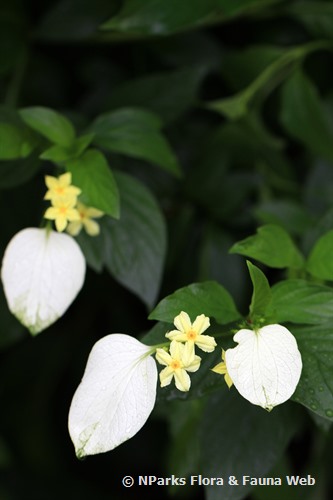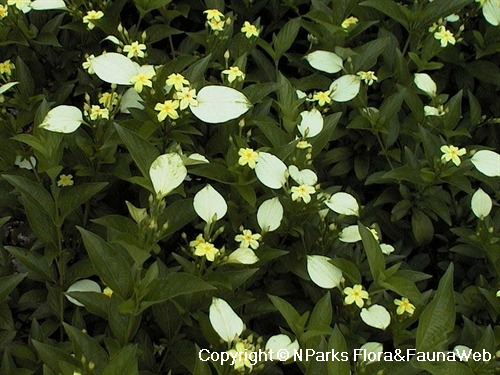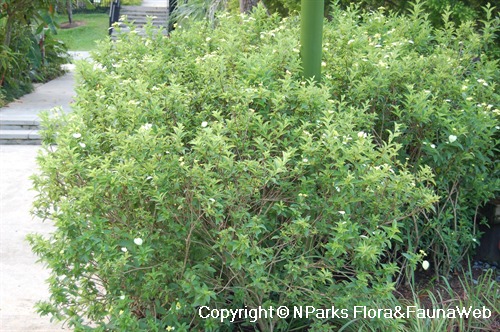
Back
Pseudomussaenda flava Verdc.
| Family Name: | Rubiaceae |
| Synonyms: | Mussaenda luteola, Mussaenda glabra, Mussaenda flava |
| Common Name: | Yellow Mussaenda, Dwarf Mussaenda, Dwarf Yellow Mussaenda, White Wing, 非洲玉叶金花 |
Name
Classifications and Characteristics
| Plant Division | Angiosperms (Flowering Seed Plants) (Dicotyledon) |
|---|---|
| Plant Growth Form | Shrub |
| Lifespan (in Singapore) | Perennial |
| Mode of Nutrition | Autotrophic |
Biogeography
| Native Distribution | Tropical Africa |
|---|---|
| Native Habitat | Terrestrial |
| Preferred Climate Zone | Tropical |
| Local Conservation Status | Non-native |
Description and Ethnobotany
| Growth Form | Shrub up to 3 m tall. |
|---|---|
| Foliage | Leaves oblong to lanceolate in shape, measuring about 4 - 9 cm long and 1.5 - 3.5 wide, sparsely pubescent on both above and below surfaces, petiole measuring about 0.1 - 0.2 cm long. |
| Stems | Stems covered with long appressed hairs. |
| Flowers | Flowers in a corymb inflorescence, corolla pale yellow and 5-lobed, 1- 2 flower per inflorescence with a single, enlarged white to creamy-yellow calyx lobe. |
| Fruit | Fruit is oblong in shape, measuring about 0.7 cm long, and contains many small seeds. |
| Etymology | This species was originally placed in the genus "Mussaenda," but later assigned to a new, separate genus named "Pseudomussaenda." Mussaenda is the common name of Mussaenda frondosa in Singhalese (a major language of Sri Lanka). The "pseudo" part of "Pseudomussaenda" is Latin for false or fake and was added to distinguish members of Mussaenda from those of Pseudomussaenda. The specific epithet "flava" comes from the Latin word "flavus" which means yellow and refers to the flower colour. |
Landscaping Features
| Desirable Plant Features | Ornamental Flowers |
|---|---|
| Landscape Uses | Parks & Gardens, Small Gardens |
Fauna, Pollination and Dispersal
| Fauna Pollination Dispersal Associated Fauna | Bee-Attracting |
|---|
Plant Care and Propagation
| Light Preference | Semi-Shade, Full Sun |
|---|---|
| Water Preference | Lots of Water |
| Rootzone Tolerance | Well-Drained Soils, Disease / Pest Resistant |
| Maintenance Requirements | Low |
| Pruning | Prune a few times a year. |
| Fertilizing | Use a granular fertilizer designed for gardenias. |
| Propagation Method | Stem Cutting |
Foliar
| Foliage Retention | Evergreen |
|---|---|
| Mature Foliage Colour(s) | Green |
| Mature Foliage Texture(s) | Hairy / Hirsute |
| Foliar Type | Simple / Unifoliate |
| Foliar Arrangement Along Stem | Opposite |
| Foliar Shape(s) | Non-Palm Foliage (Elliptical) |
| Foliar Venation | Pinnate / Net |
| Foliar Margin | Entire |
| Foliar Apex - Tip | Acute |
| Foliar Base | Acute |
| Typical Foliar Area | Mesophyll ( 45cm2 - 182.25 cm2 ) |
| Leaf Area Index (LAI) for Green Plot Ratio | 4.5 (Shrub & Groundcover - Dicot) |
Non - Foliar and Storage
| Bark Colour(s) | reddish brown |
|---|---|
| Mature Bark Texture | Lenticellate |
| Stem Type & Modification | Woody |
Floral (Angiosperm)
| Flower Colour(s) | Cream / Off-White, Yellow / Golden |
|---|---|
| Flower Symmetry | Radial |
| Individual Flower Shape | Salverform |
| Flowering Period | Free-Flowering |
Image Repository
Others
| Master ID | 1080 |
|---|---|
| Species ID | 2373 |
| Flora Disclaimer | The information in this website has been compiled from reliable sources, such as reference works on medicinal plants. It is not a substitute for medical advice or treatment and NParks does not purport to provide any medical advice. Readers should always consult his/her physician before using or consuming a plant for medicinal purposes. |



